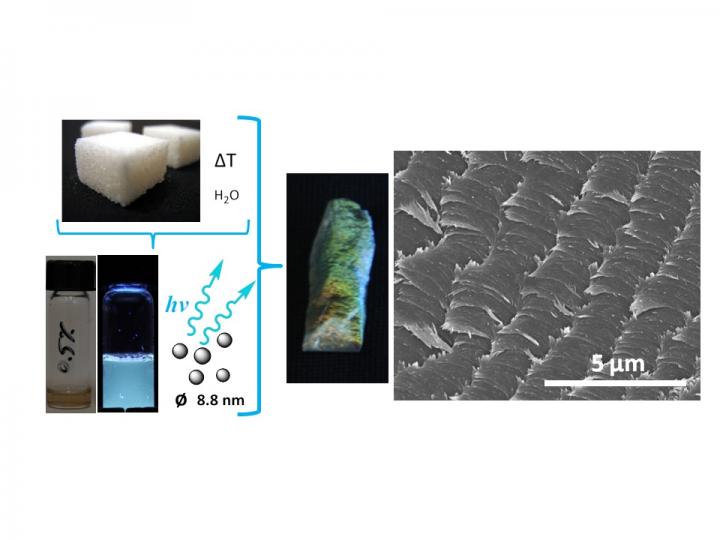

This is an image showing the process to synthesise the new material.
Credit: Erlantz Lizundia (UPV/EHU)
Erlantz Lizundia, a researcher in the UPV/EHU's department of Physical Chemistry and expert in cellulose, started the research during a period of time he spent in Canada. The research group he was in specialised in the helix-shaped organisation of a product extracted from cellulose, cellulose nanocrystals (CNCs).
Under specific conditions, the crystals can assume a helical structure, or what is the same, they can form chiral nematic structures when the crystals are organised into ordered layers, and membranes with unique properties can thus be obtained:
“The membrane displays a different colour depending on the distance existing between the layers of cellulose nanocrystals that form the helical, or chiral nematic structure. An interaction takes place between the structure and the light and, as a result, the wavelength of the light changes and materials in bright colours are obtained,” explained Lizundia. This capacity to change colour displayed by the structure “could prove very useful in enabling these membranes to be used as sensors; for example, when they are put into a humid environment, the structure will swell and the distance between the layers will increase and the colour will change,” he added.
This effect is known as structural coloration and is very common in nature. The colour of a whole host of animals (snakes, chameleons) and plants is the direct consequence of their supramolecular structure, and contrary to what one may think, is not linked to the presence of pigments. Suitable as metal sensors and for bioimaging purposes
Inserting carbon dots into the chiral nematic structure of the cellulose nanocrystals makes this material particularly suited as a detector for the presence of iron so, as Lizundia explains, “it is very useful for detecting environmental pollution or the presence of metals in the body. I, specifically, studied the material's response to zinc and iron, as they are both present in large quantities in environmental and biological matters.
I was able to see that the interaction of the metal ions with the carbon nanoparticles influences the degree of fluorescence emitted by the nanoparticles. The fluorescence diminishes in the presence of iron, whereas it increases in the presence of zinc”.
Another possible application of this material could be in bioimaging. In the research conducted, Lizundia only managed to get as far as testing that it does in fact offer this possibility. “I will shortly be embarking on research to go further into this subject and use these nanoparticles to create bioimages”. Bioimaging consists of creating images using non-invasive methods in biological processes, such as cell processes, as well as measuring the interaction between molecules in real time in the location where these interactions are taking place.
###
Additional information
The UPV/EHU researcher Erlantz Lizundia conducted his research work in collaboration with the University of British Columbia (UBC) in Canada, and with the FPInnovations organisation, also Canadian. At that time, Lizundia was a researcher in the department of Physical Chemistry on the UPV/EHU's Leioa campus. Right now, however, he is assistant lecturer in the Department of Graphic Expression and Engineering Projects in the Faculty of Engineering in Bilbao.
Bibliographic reference
E. Lizundia, T.D. Nguyen, J. L. Vilas, W. Y. Hamad, M. J. MacLachlan.. Chiroptical luminescent nanostructured cellulose films. Materials Chemistry Frontiers. 2016. DOI: 10.1039/C6QM00225K.
Wanting to go a step beyond what he had learned in Canada, Lizundia considered incorporating other functional nanoparticles into this chiral nematic structure, particles whose properties change in the presence of external stimuli. He chose some carbon nanodots, firstly because they are fluorescent, in other words, they emit colour when excited by ultraviolet light, and secondly, because he was able to obtain them by using sugar as the raw material. “I obtained these nanoparticles by subjecting glucose to hydrothermal treatment using water and heat only and by means of a fast, cheap process,” the researcher pointed out.
The final material displayed the characteristics Lizundia had been seeking. Firstly, “it is an environmentally friendly material as it is non-toxic and its raw materials are of a renewable nature, and the synthesis process is fast, simple and scalable. Secondly, the fact that the material is fluorescent gives it interesting properties enabling it to be used as a sensor,” specified Lizundia.












